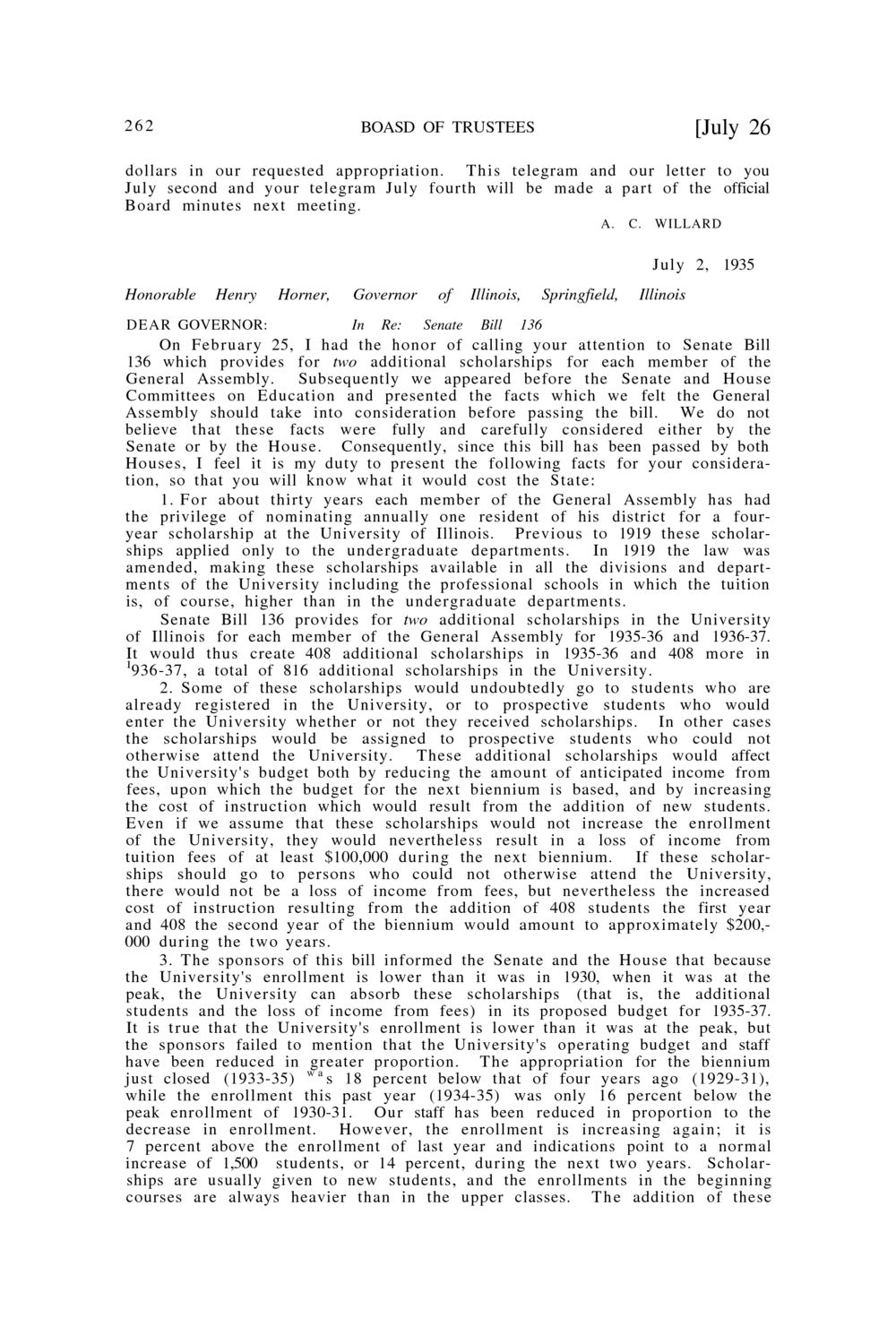| |
| |
Caption: Board of Trustees Minutes - 1936
This is a reduced-resolution page image for fast online browsing.

EXTRACTED TEXT FROM PAGE:
262 BOASD OF TRUSTEES [July 26 dollars in our requested appropriation. This telegram and our letter to you July second and your telegram July fourth will be made a part of the official Board minutes next meeting. A. C. WILLARD July 2, 1935 Honorable Henry Horner, Governor In Re: of Senate Illinois, Bill Springfield, Illinois DEAR GOVERNOR: 136 On February 25, I had the honor of calling your attention to Senate Bill 136 which provides for two additional scholarships for each member of the General Assembly. Subsequently we appeared before the Senate and House Committees on Education and presented the facts which we felt the General Assembly should take into consideration before passing the bill. We do not believe that these facts were fully and carefully considered either by the Senate or by the House. Consequently, since this bill has been passed by both Houses, I feel it is my duty to present the following facts for your consideration, so that you will know what it would cost the State: 1. F o r about thirty years each member of the General Assembly has had the privilege of nominating annually one resident of his district for a fouryear scholarship at the University of Illinois. Previous to 1919 these scholarships applied only to the undergraduate departments. In 1919 the law was amended, making these scholarships available in all the divisions and departments of the University including the professional schools in which the tuition is, of course, higher than in the undergraduate departments. Senate Bill 136 provides for two additional scholarships in the University of Illinois for each member of the General Assembly for 1935-36 and 1936-37. It would thus create 408 additional scholarships in 1935-36 and 408 more in I 936-37, a total of 816 additional scholarships in the University. 2. Some of these scholarships would undoubtedly go to students who are already registered in the University, or to prospective students who would enter the University whether or not they received scholarships. In other cases the scholarships would be assigned to prospective students who could not otherwise attend the University. These additional scholarships would affect the University's budget both by reducing the amount of anticipated income from fees, upon which the budget for the next biennium is based, and by increasing the cost of instruction which would result from the addition of new students. Even if we assume that these scholarships would not increase the enrollment of the University, they would nevertheless result in a loss of income from tuition fees of at least $100,000 during the next biennium. If these scholarships should go to persons who could not otherwise attend the University, there would not be a loss of income from fees, but nevertheless the increased cost of instruction resulting from the addition of 408 students the first year and 408 the second year of the biennium would amount to approximately $200,000 during the two years. 3. The sponsors of this bill informed the Senate and the House that because the University's enrollment is lower than it was in 1930, when it was at the peak, the University can absorb these scholarships (that is, the additional students and the loss of income from fees) in its proposed budget for 1935-37. It is t r u e that the University's enrollment is lower than it was at the peak, but the sponsors failed to mention that the University's operating budget and staff have been reduced in greater proportion. T h e appropriation for the biennium just closed (1933-35) w a s 18 percent below that of four years ago (1929-31), while the enrollment this past year (1934-35) was only 16 percent below the peak enrollment of 1930-31. Our staff has been reduced in proportion to the decrease in enrollment. However, the enrollment is increasing again; it is 7 percent above the enrollment of last year and indications point to a normal increase of 1,500 students, or 14 percent, during the next two years. Scholarships are usually given to new students, and the enrollments in the beginning courses are always heavier than in the upper classes. T h e addition of these
| |